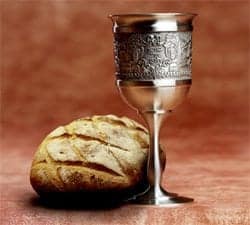The Supper of the Lord is not simply a continuation of the festival of Passover. It was instituted at that festival, and certain features of that feast are still incorporated in what we do here. For example, this cup is called by the apostle Paul the cup of blessing, which was the third cup in the Passover meal.
But there is another sense in which this meal encompasses far more than just the Passover meal—all the festivals of Israel are picked up and rolled into this sacrament, and find their complete fulfillment here. For example, after the institution of this sacrament (at Passover), the first recorded observance of it among Christians is the breaking of bread that occurred on the day of Pentecost. This is one of the reasons we use leavened bread here, and not the unleavened bread that was in use at the Passover.
If this sacrament were a strict Passover meal, not only would we have to use unleavened bread to partake, we would also have to ensure that there were no leaven on the premises anywhere. Leaven had to be removed from the house entirely. But when the disciples broke bread together on the day of Pentecost, they were doing so on a day when one of the required offerings to God was an offering of leavened bread—and so we can see that the Lord’s Supper is not a slightly modified Passover.
What does the leaven signify? Some Christians have assumed that leaven is a universally negative image in Scripture—the leaven of malice and wickedness, or the leaven of the Pharisees. But it is also used as an image of the potency of the kingdom of God. The kingdom of God is like leaven that works through the loaf.
And so this is part of what we declare in how we partake today. The kingdom of God is not like crackers. The kingdom of God is not like grape juice. We declare, as we eat and drink, the potency of obedience.
So come, and welcome, to Jesus Christ.



I found this post quite interesting, but not entirely convincing. I was aware that the Eastern Orthodox uses leavened bread for Communion, but had not heard an explanation as to why. I wonder if they use this same reasoning, or it is just a matter of tradition for them. When Pastor Wilson states that “the first recorded observance of it among Christians is the breaking of bread that occurred on the day of Pentecost,” I have to ask where this was recorded. Unless I missed it, I see no specific mention of breaking of bread in the account of the… Read more »
Evidence from the early church on the use of leavened, or unleavened, bread for Holy Eucharist is very scant. Over the centuries, the West moved to using unleavened bread exclusively while the East mostly settled on leavened bread (with some exceptions such as the Maronites and Armenian Orthodox).
The use of unleavened bread by Latin-speaking churches in Constantinople was the pretext that triggered the split between Rome and Constantinople in 1054.
For he hath made him to be sin for us, who knew no sin; that we might be made the righteousness of God in him. (2 Corinthians 5:21)
The action of the leaven has been stopped by the fire of the oven. A picture of the penalty of sin being stopped by the fires of judgement.
With all due respect, that text does nothing to clarify why the element should be changed from that which was used at the institution of the supper, unless you start from the position that it was rightly changed and then read that back into the text as a possible explanation. And even then its a really tough sell to make that a clarification, let alone a strong one.